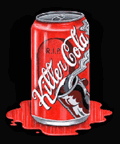Posts Tagged ‘pollution’
Dear readers,
we are proud to announce that the Kassandra Project reaches 100 000 visits in just one year of activity. This is a great goal and we thank you all for your support, for your help, for your presence.
We shared with you our knowledge, our thoughts, our ideas about:
- Pollution
- Freedom
- Corruption
- Corporation crimes
- Information and Media manipulation
- Global control and surveillance
- Privacy
- War crimes
- Civil and Human rights
- Documented governmental conspiracies
Our statistics tell us that three continents are daily reading our blog and that we have hundreds of feed subscribers. Thank you, thank you, thank you.
“In a time of universal deceit, telling the truth becomes a revolutionary act.” (G.Orwell)
Source:
LiP Magazine, June 5, 2006
Title: “Native Energy Futures”
Author: Brian Awehali
http://www.lipmagazine.org/articles/featawehali_nativefutures.htm
Student Researchers: Ioana Lupu and Mayra Madrigal
Faculty Evaluator: Dolly Freidel, Ph.D.
Energy on Native American land is becoming big business. According to the Indigenous Environmental Network, 35 percent of the fossil fuel resources in the US are within Indian country. The Department of the Interior estimates that Indian lands hold undiscovered reserves of almost 54 billion tons of coal, 38 trillion cubic feet of natural gas, and 5.4 billion barrels of oil. Tribal lands also contain enormous amounts of alternative energy. “Wind blowing through Indian reservations in just four northern Great Plains states could support almost 200,000 megawatts of wind power,” Winona LaDuke told Indian Country Today in March 2005, “Tribal landholdings in the southwestern US…could generate enough power to eradicate all fossil fuel burning power plants in the US.”
The questions to be answered now are: what sort of energy will Indian lands produce, who will make that decision, and who will end up benefiting from the production?
According to Theresa Rosier, Counselor to the Assistant Secretary for Indian Affairs, “increased energy development in Indian and Alaska Native communities could help the Nation have more reliable homegrown energy supplies.” This, she says, is “consistent with the President’s National Energy Policy to secure America’s energy future.”
Rosier’s statement conveys quite a lot about how the government and the energy sector intend to market the growing shift away from dependence on foreign energy. The idea that “America’s energy future” should be linked to having “more reliable homegrown energy supplies” can be found in native energy-specific legislation that has already passed into law. What this line of thinking fails to take into account is that Native America is not the same as US America. The domestic “supplies” in question belong to sovereign nations, not to the United States or its energy sector.
So far, government plans to deregulate and step up the development of domestic (native) energy resources is being spun as a way to produce clean, efficient energy while helping Native Americans gain greater economic and tribal sovereignty. Critics charge, however, that large energy companies are simply looking to establish lucrative partnerships with tribal corporations, which are largely free of regulation and federal oversight.
For example, in 2003, the Rosebud Sioux of South Dakota, in partnership with NativeEnergy, LLC, completed the first large-scale native-owned wind turbine in history. The project was billed as a way to bring renewable energy–related jobs and training opportunities to the citizens of this sovereign nation, who are among the poorest in all of North America.
NativeEnergy’s President and CEO Tom Boucher, an energy industry vet, financed the Rosebud Sioux project by selling “flexible emissions standards” created by the Kyoto Protocol. These are the tax-deductible pollution credits from ecologically responsible companies (or in this case, Native American tribes), which can then be sold to polluters wishing to “offset” their carbon dioxide generation without actually reducing their emissions.
Since the Rosebud test case proved successful, NativeEnergy moved forward with plans to develop a larger “distributed wind project,” located on eight different reservations. NativeEnergy also became a majority Indian-owned company in August 2005, when the pro-development Intertribal Council on Utility Policy (COUP) purchased a majority stake in the company on behalf of its member tribes.
The COUP-NativeEnergy purchase just happened to coincide with the passage of the 2005 Energy Policy Act. The act contains a number of native energy–specific provisions in its Title V, many of which set alarming precedents.
Most outrageously, it gave the US government the power to grant rights of way through Indian lands without permission from the tribes—if deemed to be in the strategic interests of an energy-related project. Under the guise of “promoting tribal sovereignty,” the act also released the federal government from liability with regard to resource development, shifting responsibility for environmental review and regulation from the federal to tribal governments. Also, according to the Indigenous Environmental Network, the act “rolls back the protections of…critical pieces of legislation that grassroots indigenous peoples utilize to protect our sacred sites.” Some critics have derided the 2005 act as a fire sale on Indian energy, characterizing various incentives as a broad collection of subsidies (federal handouts) for US energy companies.
America’s native peoples may attain a modicum of energy independence and tribal sovereignty through the development of wind, solar, and other renewable energy infrastructure on their lands. But, according to Brian Awehali, it won’t come from getting into bed with, and becoming indebted to, the very industry currently driving the planet to its doom.
UPDATE BY Brian Awehali
I believe the topic of this article was important and urgent because sometimes all that glitters really is gold, even if the marketing copy says it’s green. The long and utterly predictable history where indigenous peoples and US government and corporate interests are both concerned shouldn’t be forgotten as we enter the brave new green era. Marketing for-profit energy schemes on Indian lands as a means of promoting tribal sovereignty is both ludicrous and offensive, as are “green” development plans intrinsically tied to the extraction of fossil fuels in the deregulated Wild West of Indian Country. Energy companies are only interested in native sovereignty because it means operations on Indian lands are not subject to federal regulation or oversight. This is why I included a discussion in my article about the instructive example of the Alaska tribal corporations and the ways they’ve mutated into multi-billion dollar loophole exploiters. (My brief examination of Alaska tribal corporations drew heavily from an excellent Mother Jones article, “Little Big Companies,” by Michael Scherer). It’s also my belief that the probably well-intentioned idea of “green tags,” carbon offset credits, and market-enabled “carbon neutrality” should be examined very closely: Why are we introducing systems for transferring (or trading) the carbon emissions of “First World” polluters to those who contributed least to global warming? I would argue that this is merely a nice-sounding way for the overdeveloped world to purchase the right to continue its pathologically unsustainable mode of existence, while doing little to address the very grave ecological realities we now face.
It’s very hard to know what the impact of this story was, or to gauge mainstream response to it. In my experience, the so-called mainstream has a difficult time absorbing and understanding Native American issues, not least because this mainstream tends to think of indigenous peoples in North America in historical, rather than contemporary, terms. I am, however, encouraged by the number of journalists and writers who are beginning to ask critical questions about greenwashing, and I see my story as adding to that collective body of work.
For more information about energy policy and its impact on indigenous communities of North America, I recommend visiting the Indigenous Environmental Network (http://www.ienearth.org), and checking out their Native Energy Campaign.
 press-freedom, liberties, information, politics, news, life, censorship, top-25, energy, pollution, natives
press-freedom, liberties, information, politics, news, life, censorship, top-25, energy, pollution, natives
Americans are being treated as human guinea pigs. They are being assaulted by dangerous combinations of pharmaceutical company drug residue that passes from human waste into our taps and bottled water. But why? In the short run, Big Pharma’s goal is to slowly sicken us for profit. They create dependency on their cures and vaccines for the illnesses they have engineered. The long-run agenda is systematic global population reduction.
Big Pharma, the EPA, and municipal water authorities have attempted to suppress information regarding the pollution of drinking water. This AP article provides the disturbing details.
A vast array of pharmaceuticals — including antibiotics, anti-convulsants, mood stabilizers and sex hormones — have been found in the drinking water supplies of at least 41 million Americans.
Water providers rarely disclose results of pharmaceutical screenings, unless pressed, the AP found. For example, the head of a group representing major California suppliers said the public “doesn’t know how to interpret the information” and might be unduly alarmed.
Why bother informing the affected public? You assume they are too stupid to handle the truth anyway. Thank you Big Water spokesman for wanting to protect the citizens from information that might “alarm” them. I am sure many are easily agitated and tend to get violent when corporations and the government try to poison them.
But most treatments do not remove all drug residue. Recent studies — which have gone virtually unnoticed by the general public — have found alarming effects on human cells and wildlife.
The studies have gone “virtually unnoticed” due to the government’s attempt to keep the citizens shielded from the truth.
“We recognize it is a growing concern and we’re taking it very seriously,” said Benjamin H. Grumbles, assistant administrator for water at the U.S. Environmental Protection Agency.
No, you are not taking the threat seriously Benjamin. You only said that because your criminal negligence has been exposed.
Here are some of the key test results obtained by the AP:
_In Philadelphia, sixty-three pharmaceuticals or byproducts were found in the city’s watersheds.
_A sex hormone was detected in San Francisco’s drinking water.
_The drinking water for Washington, D.C., and surrounding areas tested positive for six pharmaceuticals.
The situation is undoubtedly worse than suggested by the positive test results in the major population centers. The federal government doesn’t require any testing and hasn’t set safety limits for drugs in water.
Maybe the lack of testing for drugs in our water has something to do with the soldiers from the pharmaceutical corporations who have a powerful lobbying influence and write the legislation and EPA regulations. Just a wild guess of course.
City water officials declined repeated requests for an interview. In one statement, they insisted that “New York City’s drinking water continues to meet all federal and state regulations regarding drinking water quality in the watershed and the distribution system” — regulations that do not address trace pharmaceuticals.
In several cases, officials at municipal or regional water providers told the AP that pharmaceuticals had not been detected, but the AP obtained the results of tests conducted by independent researchers that showed otherwise.
The officials only want to protect the people from being “unduly alarmed.” We cannot handle the truth. We might march on Washington and clamor for safe drinking water. What is the harm in a little white lie when the social order will be maintained?
Arlington, Texas, acknowledged that traces of a pharmaceutical were detected in its drinking water but cited post-9/11 security concerns in refusing to identify the drug. Officials in Emporia, Kan., refused to answer AP’s questions, also citing post-9/11 issues.
It is better that Big Pharma and the complicit government poison us than the evil “terrorists.” If the crazy Muslim fundamentalists knew what drugs were in our drinking water, they would assuredly destroy our way of life. They hate us because of our “freedoms”.
Even users of bottled water and home filtration systems don’t necessarily avoid exposure. Bottlers, some of which simply repackage tap water, do not typically treat or test for pharmaceuticals, according to the industry’s main trade group. The same goes for the makers of home filtration systems.
In other words, get used to taking your daily cocktail of other’s peoples drugs. There is nothing you can do about it anyway, so why worry?
Pharmaceuticals also permeate aquifers deep underground, source of 40 percent of the nation’s water supply. Federal scientists who drew water in 24 states from aquifers near contaminant sources such as landfills and animal feed lots found minuscule levels of hormones, antibiotics and other drugs.
Another issue: There’s evidence that adding chlorine, a common process in conventional drinking water treatment plants, makes some pharmaceuticals more toxic.
Ask the pharmaceutical industry whether the contamination of water supplies is a problem, and officials will tell you no. “Based on what we now know, I would say we find there’s little or no risk from pharmaceuticals in the environment to human health,” said microbiologist Thomas White, a consultant for the Pharmaceutical Research and Manufacturers of America.
“Based on what we now know” – which is virtually nothing since the data is purposefully suppressed. Certainly a consultant for Big Pharma would provide a thoroughly objective analysis of the dangers posed by drugs in the water supply. It is not like his paycheck depends on it or anything.
But at a conference last summer, Mary Buzby — director of environmental technology for drug maker Merck & Co. Inc. (soon to be unemployed) — said: “There’s no doubt about it, pharmaceuticals are being detected in the environment and there is genuine concern that these compounds, in the small concentrations that they’re at, could be causing impacts to human health or to aquatic organisms.”
Recent laboratory research has found that small amounts of medication have affected human embryonic kidney cells, human blood cells and human breast cancer cells. The cancer cells proliferated too quickly; the kidney cells grew too slowly; and the blood cells showed biological activity associated with inflammation.
Also, pharmaceuticals in waterways are damaging wildlife across the nation and around the globe, research shows. Notably, male fish are being feminized, creating egg yolk proteins, a process usually restricted to females. Pharmaceuticals also are affecting sentinel species at the foundation of the pyramid of life — such as earth worms in the wild and zooplankton in the laboratory, studies show.
Some scientists stress that the research is extremely limited, and there are too many unknowns. They say, though, that the documented health problems in wildlife are disconcerting.
“It brings a question to people’s minds that if the fish were affected … might there be a potential problem for humans?” EPA research biologist Vickie Wilson told the AP. “It could be that the fish are just exquisitely sensitive because of their physiology or something. We haven’t gotten far enough along.”
Sounds like it requires further study Vickie. In the meantime, we should freely imbibe our chemical cocktails and roll the dice. I mean it is just our health right? Besides, who wants to live forever? Screw the animals and environmental impact.
There’s growing concern in the scientific community, meanwhile, that certain drugs — or combinations of drugs — may harm humans over decades because water, unlike most specific foods, is consumed in sizable amounts every day.
Our bodies may shrug off a relatively big one-time dose, yet suffer from a smaller amount delivered continuously over a half century, perhaps subtly stirring allergies or nerve damage. However, some experts say medications may pose a unique danger because, unlike most pollutants, they were crafted to act on the human body.
“We know we are being exposed to other people’s drugs through our drinking water, and that can’t be good,” says Dr. David Carpenter, who directs the Institute for Health and the Environment of the State University of New York at Albany.
Maybe you should not be so worried about this news. I am sure that the elected officials, and their political agency appointees, recognize the importance of protecting every American’s health and safety. I am sure that measures to keep our water safe are being implemented as I type this.
General Jack D. Ripper: You know when fluoridation first began?
Group Capt. Lionel Mandrake: I… no, no. I don’t, Jack.
General Jack D. Ripper: Nineteen hundred and forty-six. Nineteen forty-six, Mandrake. How does that coincide with your post-war Commie conspiracy, huh? It’s incredibly obvious, isn’t it? A foreign substance is introduced into our precious bodily fluids without the knowledge of the individual. Certainly without any choice. That’s the way your hard-core Commie works.
 Business, Environment, Government, Health, Human-rights, Law, Life, News, Politics, Pollution,
Business, Environment, Government, Health, Human-rights, Law, Life, News, Politics, Pollution,







 E-mail Subscribe
E-mail Subscribe


































